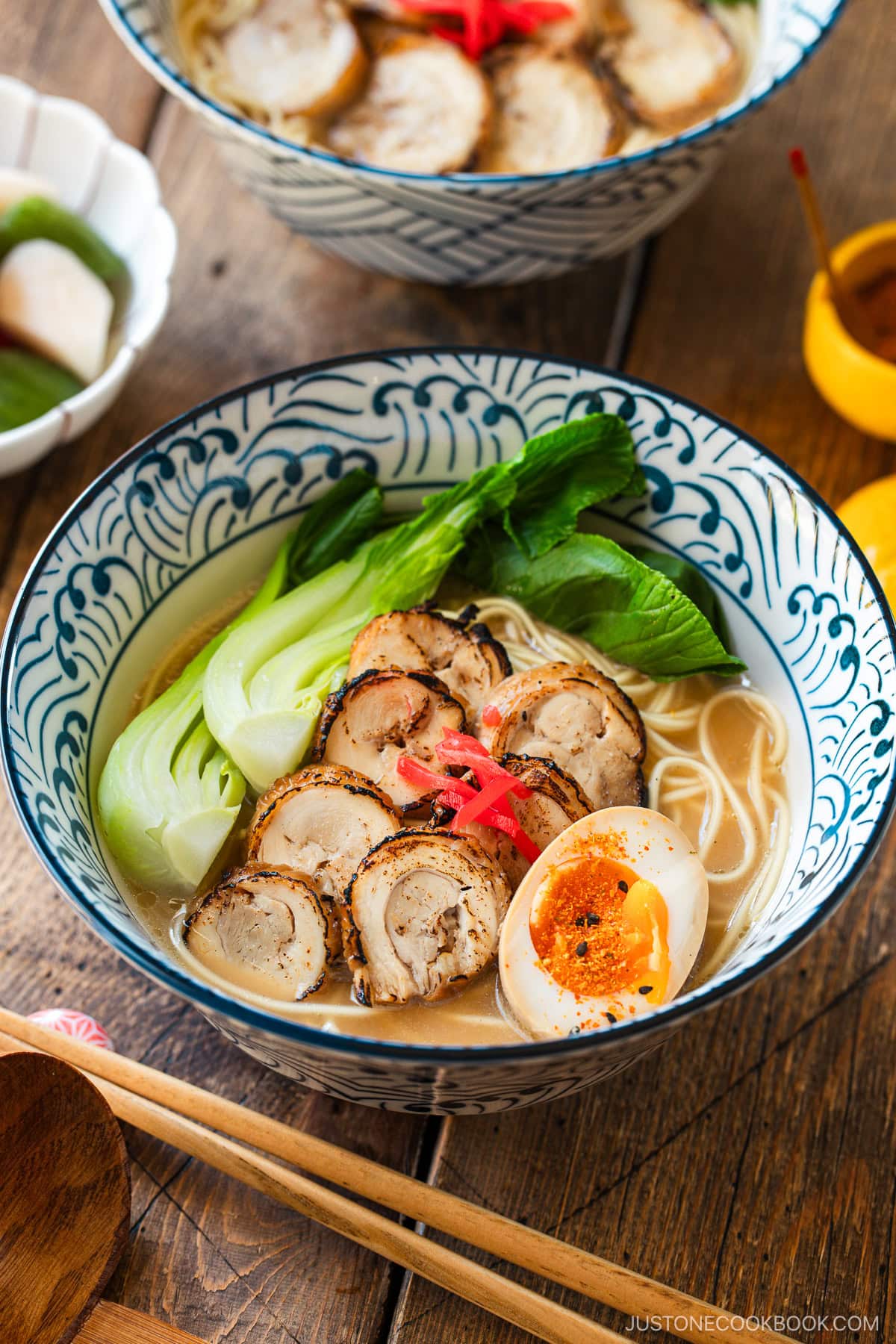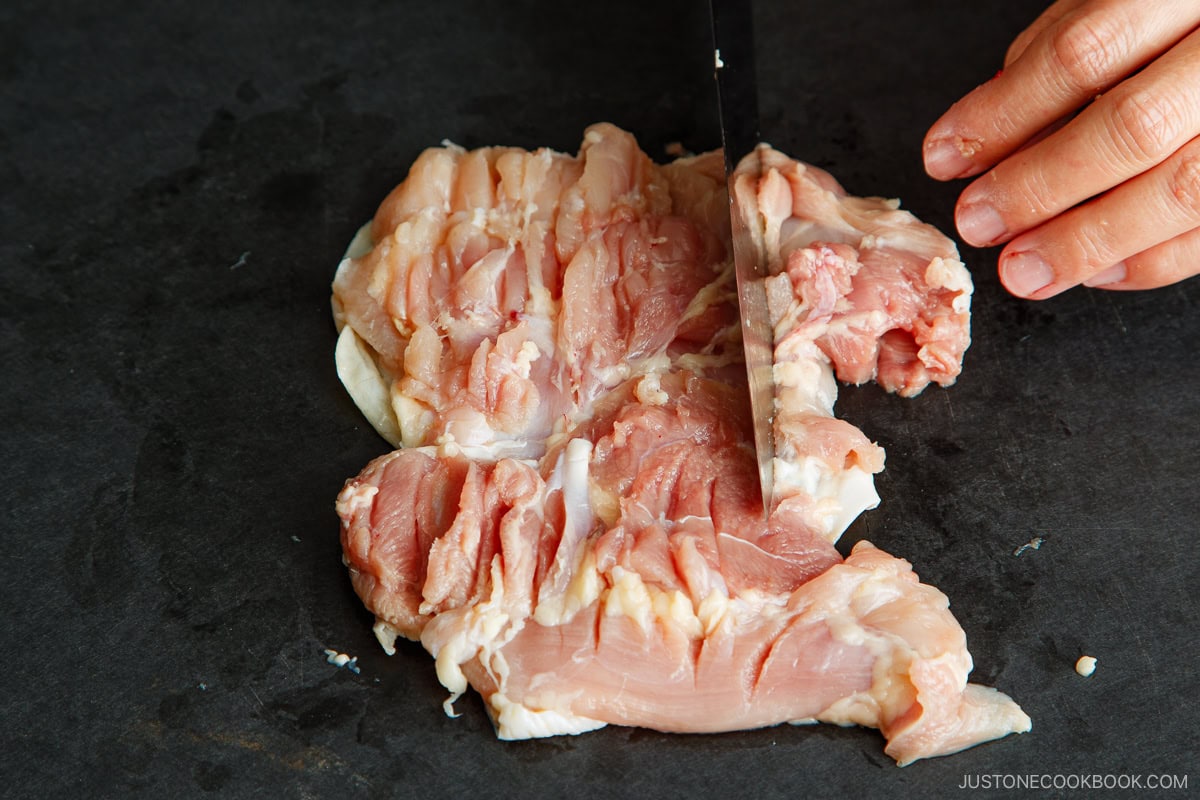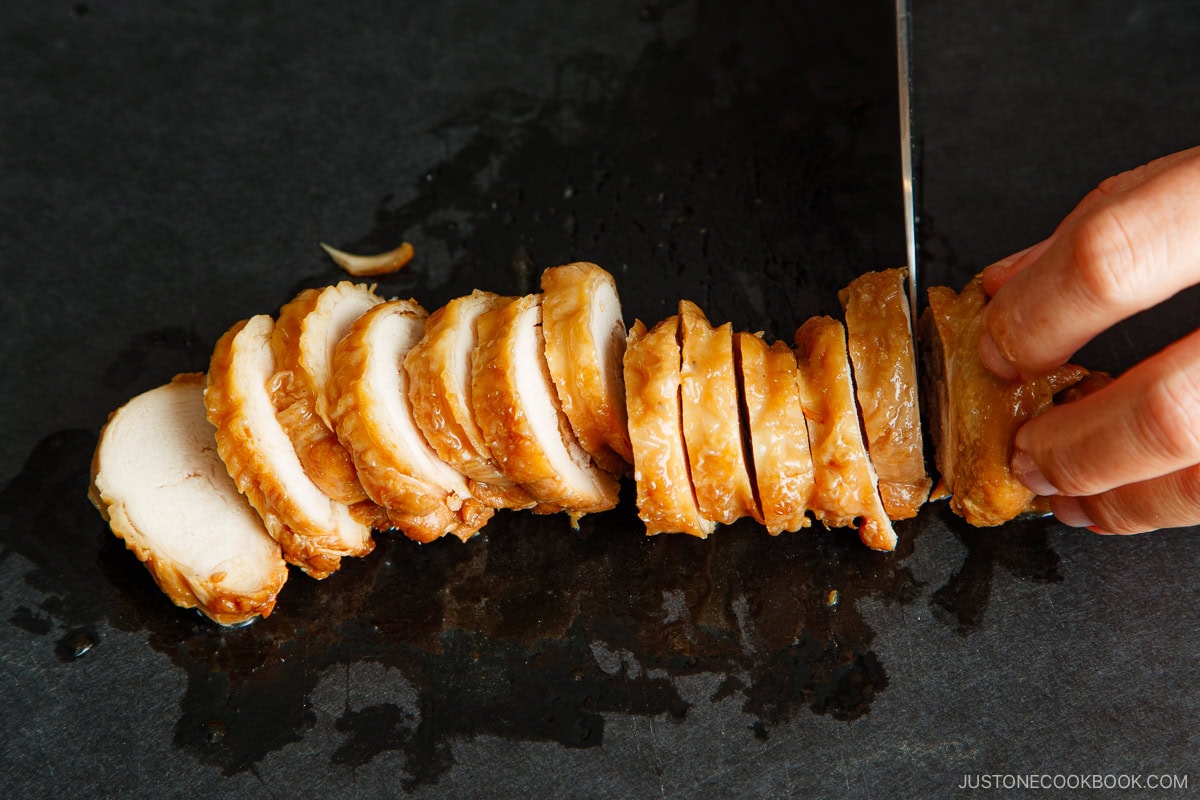Juicy and tender Chicken Chashu is a lighter variation on Japanese pork belly chashu. Here, I roll and pan-sear chicken thighs, then braise and marinate them in a sweet-savory sauce. The smoky, succulent slices are perfect on ramen, in a rice bowl, or on their own!
One of my family’s favorite recipes that I make at home is Chashu, the classic Japanese braised pork belly. Today, I’m sharing a lighter, leaner, and quicker variation that I like even better—Chicken Chashu. Made with skin-on chicken thighs, this recipe is just as succulent and delicious! I’m excited to show you how easy it is to make this nutritious and versatile Japanese home-cooking dish.
If you’re craving more chicken recipes, try my Chicken Teriyaki, Chicken Katsu, and Karaage next!
What is Chashu?
Chāshū (チャーシュー) is the Japanese adaptation of the famous Chinese barbecued pork dish called char siu (叉燒). Whether made with pork belly or chicken thighs, the Japanese version differs significantly from the Chinese dish in seasoning, cooking method, and texture. Chashu is braised in typical Japanese pantry condiments while char siu is barbecued or roasted with Chinese flavorings like hoisin sauce and five-spice powder. While Chinese char siu has a firm texture, Japanese chashu is succulent and tender; it makes the perfect complement to ramen noodles or a donburi rice bowl.

Why I Love This Recipe
- A leaner version of chashu – While pork chashu is the classic preparation, I honestly prefer chicken chashu for its lower fat content and clean finish. It’s a light and nutritious home-cooking dish that I love making for my family.
- Juicy, tender, and melts in your mouth – The succulent, moist slices of rolled chicken thighs are incredibly tender. I find them nearly irresistible!
- Uses easy-to-find ingredients – Boneless, skin-on chicken thighs are so easy to source at any local grocery store. The seasonings are basic Japanese condiments that you may already have in your pantry, too.
- Cooks quickly – I spend less than 30 minutes at the stove to braise this chicken! The short cooking time is really convenient for busy moms like me.
- Rests overnight to soak up the seasonings – I seared and braised chicken rolls overnight in the sweet-savory cooking liquid to intensify the flavors. It pairs so well with plain steamed rice and ramen noodles.

Ingredients for Chicken Chashu
- Boneless, skin-on chicken thighs – use the largest ones you can find
- Fresh ginger slices
- Green onions/scallions
- Sake
- Mirin
- Soy sauce
- Sugar
- Water
- Neutral oil – for searing
Find the printable recipe with measurements below.
Jump to Recipe
Substitutions
- Soy sauce: Use tamari soy sauce for gluten-free.
- Sake: You can use Chinese rice wine or dry sherry, but I highly recommend sake for Japanese recipes.
- Mirin: It’s much easier to buy this Japanese condiment these days, and it’s even available online. Please try to find it rather than substituting it with sugar and sake (or water), which is not exactly the same thing.
- Green onions/scallions: You can substitute it with some leek or Tokyo negi (also called naga negi or long green onion).
Key Kitchen Equipment
- Butchers twine or kitchen string
- Drop lid (otoshibuta) – If you don’t have one, you can make it at home with aluminum foil; see my What is Otoshibuta post to learn how.
- Culinary butane torch – It’s optional, but I love the charred smoky flavor that searing adds to the chashu slices.

How to Make Chicken Chashu
Preparation
Step 1 – Cut the aromatics and trim the chicken. Cut the peeled ginger into thin slices and cut the green onions into shorter pieces. Trim the chicken of any excess fat and white, stringy connective tissue (tendons).


Step 2 – Flatten the meat so it’s easier to roll. With the skin side down, score the flesh across the fibers and connective tissue to open up the meat, then pound it with the back of your knife to flatten the meat well.


Step 3 – Roll the thighs snugly and tie with kitchen twine. Turn the chicken sideways and start rolling tightly from the bottom edge. Roll parallel to the scoring. Tie and/or wrap securely at 1/2-inch (1.5-cm) intervals.


Cooking and Marinate
Step 4 – Sear the chicken rolls and simmer in the seasonings. Preheat a pot that’s just big enough to fit the rolls over medium-high heat. Then, sear the chicken in the oil, seam side down. Rotate to brown all sides. Add the aromatics and seasonings, bring to a boil, and braise in the broth until cooked through.


Step 5 – Rest overnight in the cooking liquid. Transfer the rolls and braising sauce to a container. Cool completely, cover, and refrigerate overnight to soak in the flavors. Add optional peeled boiled eggs to the liquid to make ramen eggs.


Sear and Serve
Step 6 – Slice and sear. Cut the roll into 1/2-inch slices and sear with a kitchen torch until warmed and lightly charred for a smoky flavor.


Enjoy over ramen or rice drizzled with extra sauce on top!


Nami’s Recipe Tips
- Get the biggest chicken thighs you can find. To successfully roll up the chicken, you’ll need to use very large thighs. It’s extremely difficult to roll up a small thigh because it’s not long enough for one end to overlap the other. The goal is to create a roll similar in shape to the Japanese character “の.”
- Use skin-on thighs. The chicken skin adds great flavor when seared and also helps to keep the meat moist during braising.
- Flatten the meat so it’s easier to roll. This is the key to a successful roll. Score the flesh, especially in the thick parts, to cut the connective fibers and open up the meat. Then, pound it with the back of the knife to flatten and even out the thickness.
- Roll the chicken tightly, and tie it snugly (not too loose or tight!) If it’s too loose, it may fall apart. If it’s tied too tightly, the twine may indent the chicken and ruin the roulade’s shape.
- Sear the chicken roll well. This step makes a great difference, enhancing the dish with complex layers of flavor. My go-to choice for searing meats is a carbon steel pan or a cast iron pot like I use here. You can really turn up the heat, and the food comes in direct contact with an evenly heated surface.
- Don’t skip the ginger and long green onion. These ingredients help remove any unsavory odor and add more depth to the sauce.
- Rest the chicken overnight in the braising liquid. You may be tempted to skip this step, but please be patient. Marinating for 8 hours is crucial for the chicken to absorb all the sweet and savory flavors of the braising liquid. I love the concentrated flavor that this simple technique imparts.
Variations and Customizations
Here, I suggest a few easy twists to vary the taste, shape, or ingredients of this recipe.
- Skip rolling. If you’d don’t mind the look, you can simply cook the chicken thighs without rolling and tying them. The slices won’t be round, but they’ll still have the same delicious chashu flavor. I recommend using a shorter braising time since it won’t take as long to cook as the thicker rolled version. Also, please check your marinating chicken sooner as you may not need the full 8 hours marination time.
- Make ramen eggs at the same time. The seasoning liquid works perfectly for ramen eggs (ajitsuke tamago). I always add a few peeled and boiled eggs to marinate in the sauce with the resting chicken. The next day, I can use both as toppings for my donburi bowl or ramen noodles. Bonus: The leftover seasoning also makes a great stir-fry sauce or a marinade for grilling meat!
- Change up the seasonings and aromatics. Use the Japanese seasonings in my recipe as a starting point for your own custom flavorings. Take it any direction you’d like with chili oil, hoisin sauce, five spice powder, chili oil, gochujang, garlic, and more—the possibilities are endless.

What to Serve with Chicken Chashu
Besides enjoying chicken chashu as a ramen topping or main dish, you can also serve it with many other dishes. Here are my suggestions:

Storage and Reheating Tips
To store: Transfer the chicken chashu and eggs out of the marinade to a new airtight container. You also can save the marinade in a separate jar or container to drizzle on your chashu rice bowl or use as a stir-fry sauce or marinade for grilling meat. Store in the fridge for up to 7 days or up to 1 month in the freezer. Defrost overnight in the fridge before reheating.
To reheat: You have three options for reheating: 1) Soak the chashu slices in hot cooking sauce, 2) directly add it to your bowl of ramen or hot noodle soup, or 3) sear using a culinary butane torch. We call this aburi chashu (炙りチャーシュー), as aburi means searing in Japanese.
Frequently Asked Questions
Chicken chashu is ideal to prep ahead of time, as it requires an overnight resting period to soak up the seasoning flavors. It also keeps in the refrigerator for up to 7 days and in the freezer for up to 1 month, so you can use it for different meals throughout the week/month.
There are three possibilities. First, you might have rolled or tied the chicken too loosely. Next time, make sure to roll it tightly so the end overlaps the rolled meat and tie it snugly with kitchen twine. Second, it’s possible that your chicken thigh was too small. Be sure to use the largest chicken thigh that you can find. Third, the meat might not be flat enough. Be sure to score the flesh and pound it to get it as flat and evenly thick as possible so you can roll it successfully.
For a thicker roulade, please use a boneless, skin-on chicken leg with the thigh and drumstick meat attached in one long piece. When you roll it, start from the drumbstick side (the short side) and end at the thigh.
The butcher counter at a Japanese market often carries boneless chicken leg with the skin on. Alternatively, you can ask your butcher to debone a chicken leg in one piece or debone it yourself, if you know how.
I don’t recommend it. Chicken breasts dry out easily, so it’s not ideal for this dish.
More Chicken Recipes
If you love this Chicken Chashu, you’re in for a treat with these other irresistible chicken recipes.


Prevent your screen from going dark
To Prepare the Ingredients
-
Cut 2 green onions/scallions into 2-inch (5 cm) lengths. Peel the ginger knob and thinly cut about 5 slices ginger.
-
Trim off the excess fat and the white, stringy connective tissue (tendons) from 2 boneless, skin-on chicken thighs.
-
Score the flesh to open up the meat, cutting the connective fibers at ½-inch (1.5-cm) intervals, especially on the thickest parts. Then, gently pound the flesh with the back of your knife to flatten and make rolling easier. Fill any empty spots with trimmed pieces of meat to create a more even surface.
To Cook
-
Preheat a pot just big enough to hold the chicken rolls over medium-low heat. Then add 2 tsp neutral oil. When the oil is hot, place the rolled chicken in the pot, seam side down.
-
Sear the skin without moving it for about 2 minutes until the seam is set. Occasionally, carefully roll the chicken without tearing the skin.
-
Sear until all sides are evenly browned, about 10 minutes. Turn off the heat and use a paper towel to wipe away any excess fat.
-
Pour 1 cup water into the pot and gently scrape the browned bits off the bottom using a wooden spatula.
-
Add ½ cup mirin, ½ cup soy sauce, ½ cup sake, and 2 Tbsp sugar.
-
Stir the seasonings with the spatula. Add the ginger slices and green onion.
-
Bring it to a boil over medium heat.
-
Once boiling, cover with a lid and simmer over medium-low heat for about 7–8 minutes.
-
Remove the lid and flip the chicken. Now, place a drop lid called otoshibuta on the meat. See my What is Otoshibuta post to learn why we use it and how to make one at home; or you can buy one on Amazon. Simmer for an additional 6–7 minutes (you don’t need to cover with the pot’s lid).
-
Increase the heat to medium-high and continue simmering, basting the chicken with the sauce until it thickens and develops a glossy glaze, about 5 minutes.
-
Remove the ginger and green onion.
To Marinate Overnight
-
Transfer the chicken and all the braising liquid to a storage container.
-
Let it cool, cover, and refrigerate overnight to allow the chicken to soak up the sauce for the best flavor. I like to add peeled boiled eggs to the marinade to make ramen eggs.
To Store
-
Transfer the chicken chashu and eggs out of the marinade to a new airtight container. You also can save the marinade in a separate jar or container to drizzle on your chashu rice bowl or use as a stir-fry sauce or marinade for grilling meat. Store in the refrigerator for up to 7 days or up to 1 month in the freezer. Defrost overnight in the fridge before reheating. To reheat, you have three options: 1) Soak the chashu slices in hot cooking sauce, 2) directly add it to your bowl of ramen or hot noodle soup, or 3) sear using a kitchen torch.




